Small communities in the primeval societies used to bury solid waste just outside their settlement, discharge aqueous waste into the local waterbodies and release gaseous pollutants into the atmosphere. The increase in community size, necessitated a more organised form of waste management to minimize the environmental impacts as the quantity of pollutants exceeded the system’s threshold. The stabilization of health issues at personal levels gave impetus to the community health issues. The earliest records show that the city of Mahenjo-Daro (Indus Valley) had organised solid waste management processes, Crete had trunk sewer systems by 2000 BC (Vesilund et al. 2002) and the burning of soft coal in kilns in 1285 BC was banned to mitigate air pollution in London (Molak 1997). Health and safety issues have been focus of waste management since early years (Ponting 1991). The general public is more concerned with the effects that waste has on the environment while for the waste managers and planners the cost of collection, processing and disposal gains importance with the growing problem. Thus different waste management practices gained utmost importance as human activities exceeded the assimilative capacity of the biosphere.
Many countries have introduced statutory waste minimisation and recovery targets to address the earth’s dwindling resources and the growing mountains of waste. In order to enable the legislators to deal with the waste management, it became necessary to define what constitutes waste. The Resource Conservation and Recovery Act (1976) of USA defines solid waste as “any garbage, refuse, sludge from a waste treatment plant, water supply treatment plant, or air pollution control facility, and other discarded material, including solid, liquid, semisolid, or contained gaseous material resulting from industrial, commercial, mining, and agricultural operations, and from community activities”. The German Waste Act (1972) defines waste as the “portable objects that have been abandoned by their owner (s)” or “requiring orderly disposal to protect the public welfare” (Bilitewski et al. 1997). Broadening the scope beyond solid forms of waste, New Zealand Waste Strategy defines waste as “any material, solid, liquid or gas, that is unwanted and/or unvalued, and discarded or discharged by its owner”. Disposal of waste to the biosphere has given way to thinking about, and trying to implement, an integrated waste management approach. In 1996, the United Nations Environmental Programme (UNEP) defined integrated waste management as a framework of reference for designing and implementing new waste management systems and for analysing and optimising existing systems.
As human needs and activities overload the assimilative capacity of the biosphere, the debate on the sustainable waste management has become paramount. Advances in the environmental measurement techniques have shown that the current demand on the earth’s resources is not sustainable and needs addressing immediately (York et al. 2004). Solid waste management has evolved greatly since its early days and it now considers an interrelated series of options aiming at waste source reduction, recycling, treatment and final disposal. A system analysis approach has become necessary while considering many options available and a system model is desirable because of the interactions between many factors within a waste management system. A concise definition of a system is ‘‘ a set of interacting units or elements that form an integrated which is intended to perform some function’’(Skyttner 1996). In a system approach the problems are multidimensional and multidisciplinary and so the solutions must reflect this complexity. The multidimensional aspect includes the economic sector. A systems approach requires a long-term perspective, and analysis may need to extend across geo-political borders (Sodeerbaum 1987). Thus, systems analysis plays an important role for regionalization assessment of integrated solid waste management systems, providing the decision makers with breakthrough insights and risk-informed strategies.
Appropriate waste management policy would be based on the principles of sustainable development, according to which society’s refuse should not be regarded simply as something to eliminate but rather as a potential resource. Solid waste management facilities are crucial for environmental management and public health in urban regions. Due to the waste management hierarchy, one of the greatest challenges that organizations face today is to figure out how to diversify the treatment options, increase the reliability of infrastructure systems, and leverage the redistribution of waste streams among incineration, compost, recycling, and other facilities to their competitive advantage region wide. Techniques for solving regional waste problems inevitably have a large number of possible solutions due to variable population densities, incomes, multiple (actual and potential) locations for waste management infrastructure, protected landscape areas and high value ecological sites. This requires creation of an integrated waste management plan that makes full use of all available technologies. This would entail an increase in material recycling and energy recovery, and landfill disposal option only for inert materials and residues from recovery and recycling as shown in Fig. 1. In this context, the European Union guidelines stipulate the reduction of the present levels of waste generation and the increase in energy and material recovery, which represent two of the most important future requirements for environmentally-sound waste management practices. Landfill is generally recognized as the final destination of the refuse that cannot be further segregated or recovered in any other way.
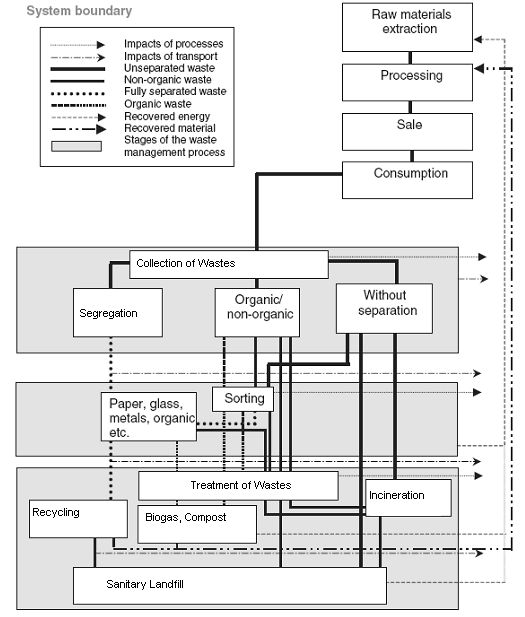
Fig. 1. Material flow in the municipal solid waste management system
Despite the development of strategic planning models, the descriptions of source separation strategies of recyclables are usually insufficient to enable calculation of the amounts of materials separately collected. The amount of a material separately collected in an area depends on two factors: (1) the coverage of a collection system applied and (2) the separation activity of waste producers, consisting of participation rate and separation efficiency. The coverage of a collection system is defined as the ratio of (a) the amount of a material produced in those properties where separate collection is available and (b) the amount of the material in question produced in all properties of the area. Participation rate is defined as the share of people providing sorted material to bins in those places where this option is available. Separation efficiency is defined as the share of a material that is correctly separated by those participating in separation. In several strategic planning models, all of these factors have been ignored and the amounts of materials separated at the source are treated as input data.
Solid waste management is particularly difficult and costly today due to the increasing volumes of waste and the need to control potential serious environmental and health effects of disposal. National planning for solid waste management is necessary for the development and implementation of a very long-term and reliable action. A report on waste management prepared for the government of India (1998) by a sub-committee of the Supreme Court relates what it describes as a ‘pathetic situation’. The municipal bodies in India have been unable to adjust to the rapid changes that have led to both increased quantities and changes in the composition of the waste stream, leading to an over-loading of the service. It is estimated that more than a quarter of the waste generated is not collected (Pauchri and Batra 2001). The current situation, which gives rise to the indiscriminate dumping of wastes, has a serious impact on air, land and water pollution and causes a dramatic increase in health hazards in the urban environment. A report prepared by the World Bank (1994) advocated a move towards privatisation of the service, and this has been started in some cities, but involvement of civil society organisations could provide alternative solutions. In many cities non-governmental and community-based organisations (NGOs and CBOs) have started developing neighbourhood waste collection services as well as initiating composting and recycling activities. These moves are backed up by new municipal solid waste management and handling rules (Ministry of Environment and Forests, GOI, 2000). Among other requirements, this rule demand source segregation and waste recovery, the local authorities in charge of municipal bodies have a statutory obligation to collect and dispose of household waste.
Refuse is no longer considered as ‘‘waste’’ these days, but rather something that must be recovered or re-used as a potential resource (Korhonen et al.2004). The work carried out over the years in this regard includes analysis of waste generation determinants, waste management facilities (Chang et al. 1996), waste treatment methods (Huhtala, 1997), environmental impacts of different technologies (Powell Jane, 1996), economic aspects of managing waste (Jenkins et al. 2000), transportation (Bhat, 1996; Kulcar, 1996), macroeconomics of recycling (Ferrer and Ayres, 2000) and complex planning (Chang et al. 1997), management costs, air, water and soil pollution, road congestion, technological reliability, environmental–economic analysis of municipal solid waste management systems on the regional level.
Efficient planning for municipal solid waste (MSW) management systems requires accounting for the complete set of environmental effects and costs associated with the entire life cycle of the waste. Life cycle assessment ( LCA) is a process used to evaluate the environmental burden associated with a product, process or activity and to consider opportunities that can effect environmental improvements. The International Organisation for Standardisation (ISO), a worldwide federation of national standards bodies, has standardised the framework on LCA. The main barriers include lack of awareness of the importance of using the life cycle concept, the quality of the data and a general lack of understanding of how to conduct the LCA correctly and interpret the results. The environmental impacts of a number of waste management scenarios have been compared using a life cycle assessment (LCA) by Emery et al.(2006). An interactive model was developed to examine the costs, employment and recovery rates using various waste recovery methods including kerbside recycling and incineration. The LCA analysis showed the incineration option to be more favourable than the landfill, recycling or composting options. However, the economic modelling results showed higher running costs and lower associated jobs when compared to the other options such as recycling. The study indicated that integrated waste management would ultimately be the most efficient approach in terms of both economics and environment benefits.
Integrated solid waste management System
Integrated solid waste managemnt (ISWM) in its simplest sense incorporates the waste management hierarchy (Tchobanoglous et al., Turner and Powell 1991) by considering direct impacts (transportation, collection, treatment and disposal of waste) and indirect impacts (use of waste materials and energy outside the waste management system). It is a framework that can be built on to optimize the existing systems, as well as to design and implement new waste management systems (UNEP 1996, 2002). ISWM is also a process of change that gradually brings in the management of wastes from all media (solid, liquid and gas). Pimenteira et al. (2005) analysed the socioeconomic aspects of solid waste management to examine reintroduction of the secondary product resulting from recycling into the productive process. The results suggested that an increase in the collection of recyclable materials from households can reduce the emission of greenhouse gases. The use of recycled materials in place of virgin materials in production also leads to reduction in the demand for energy.
Colon and Fawcett (2006) have presented two case studies on the efforts by a community-based organisation to promote a sustainable integrated waste management system in Indian mega cities - Chennai and Hyderabad. They identified solid waste management as a medium to promote a new model of society based on participative democracy. It places solid waste management at the core of society: its moral values, its social structure, its lifestyle, its economics and politics. The model itself raises the fundamental issue of governance. It stresses the need for local bodies to be more aware of people’s concerns and for citizens to be more involved in civic affairs. The study highlights the need to develop a sound management structure, seek technical and institutional support, and possibly work more closely with the private sector in reclaiming the full value of the waste resource in order to finance and support the collection schemes.
Planning integrated solid waste management
Any city or town will be in need of an effective solid waste management system to ensure better human health and safety. The system needs to be safe for workers and safeguard public health by preventing the spread of disease. In addition to these prerequisites, an effective solid waste manage must be environmentally sustainable and economically feasible. It is quite difficult to minimise the environmental impacts and the cost simultaneously. The balance that needs to be struck is to reduce the overall environmental impacts of waste management as far as possible, within an acceptable level of cost. An economically and environmentally sustainable solid waste management system is effective if it follows an integrated approach i.e. it deals with all types of waste beginning from its generation to its disposal. The integrated approach must be based on a logical hierarchy of actions. The planning of ISWM is explained below in a Bangalore case study.
Many corporation wards in Bangalore city are characterized by having a high degree of fermentable component in municipal solid wastes (MSW) from residential areas. These wastes are typified with low calorific value (800-1800 kCals/kg), high moisture content (50-80%, low net cal value), high proportion of organic matter (>60%) and low recyclable content such as paper, plastics, metals etc. The fermentable components of MSW are predominantly vegetable and fruit wastes that can range between 65 and 90% (Rajabapaiah 1998, TIDE 2000, Aus-AID 2002, Hui et al. 2005, Ramachandra 2006, Chanakya et al. 2007, 2009). As and when the city begins source segregation into fermentables, recyclables and that to be inertized, as specified by MSW rules (Ministry of Environment and Forests 2000), it is expected that a significant component of fermentable fraction will be produced and needs to be picked up on a daily basis. Only 68% of wastes generated is being collected by the agencies in Bangalore. The comparative analysis in other major cities (as in 2000) is given in Table 1.
Table 1. Quantum of waste generation and collection in major Indian cities
| City | Generated (ton/day) |
Collected (ton/day) |
Collection (%) |
| Bangalore | 1800 | 1225 | 68.05 |
| Chennai | 1819 | 1637 | 89.99 |
| Mumbai | 3200 | 3100 | 96.88 |
| Ahmedabad | 1200 | 1080 | 90.00 |
| Kanpur | 2142 | 1500 | 70.02 |
| Pune | 1000 | 700 | 70.00 |
| Lucknow | 600 | 500 | 83.33 |
The quantum of waste generated in Bangalore city varies from 1700 MT/day to 2300 MT/day and the composition of waste is given in Table 2. The Bangalore Metropolitan Area is on the whole divided into 30 ranges and 100 revenue wards under the jurisdiction of the Bangalore Mahanagar Palika (BMP). BMP is responsible for the solid waste management planning and execution. Revenue wards are further divided into 294 health wards for proper management of the sanitation functions. Out of these 112 health wards are managed by the BMP, while 182 wards have been assigned to private agencies on contract basis.
Table 2. Composition of municipal solid waste at different stages in Bangalore
| Components (%) | Street bin, before rag picking | Street bin, after rag picking | Dump site | Bangalore overall |
| Fermentables | 65 | 78 | 70 | 72 |
| Paper | 8 | 4 | 11.4 | 11 |
| Miscellaneous | 12 | 15 | 8.7 | 1.9 |
| Glass | 6 | 1 | 0.5 | 1.4 |
| Polythene /plastics | 6 | 1.9 | 9.1 | 6..2 |
| Metals | 3 | 0.1 | 0.3 | 1 |
| Dust and sweepings | NA | NA | NA | 6..5 |
The current waste generation in Bangalore is 3613 tonnes per day (in 2005-06) and the number is likely to grow in the next few years due to the increasing population and will present a formidable challenge to authorities unless an integrated approach is taken. As the daily per capita organic fraction of MSW production varies between 0.2-0.5kg in Karnataka state, depending upon lifestyles in the cities (indicated by city population). Thus, due to the small size of the total fermentable MSW generated at the household scale only composting and vermicomposting seem feasible at the household level. Many commercial and non-commercial devices for household composting and vermicomposting have been tried in Bangalore (Aus-AID 2002). Most of these have run into difficulties either due to excessive malodours due to the generation of large volumes of leachates and organic acids in case of household composters and worm predation or worm migration in household vermicomposting devices (Chanakya et al. 2006; TIDE 2000, TIDE 2003). Area or community scale options indicated above have been more successful in Bangalore and in various places in India. Area or zone wise collection has been shown to simplify collection systems and it enables collection of waste of similar composition (Sathishkumar et al. 2001). Leaf litter and garden waste, vegetable and fruit waste, domestic and kitchen waste, etc. thus are manually carted and treated at scales between 0.05-0.25 tpd scale (TIDE 2003). Composition of waste (Table 2) clearly shows the predominance of fermentable materials at all locations in the process of generation to its reaching the dump site. In the residential areas, parks and vegetable markets, the presence of a large fraction of fruit and vegetable waste (fermentable fraction, 70-90%) increases the moisture content of waste to about 70-80% (TIDE 2003). When composting of such high moisture feedstock is attempted by the standard windrow method, there is excessive generation of leachates and its fermentation results in malodours. High levels of such waste arise even in the business districts where there is a concentration of fresh fruit juice vending shops in the area. Citrus fruit skins, pineapple cores, sugarcane bagasse, other fruit waste, etc. are generated in large quantities in certain pockets of the city. These form nearly 80% of the waste collected area (Sathishkumar et al. 2001). It is, therefore, important that such waste materials are treated rapidly in decentralized units and two options, namely, aerobic composting and biomethanation are available.
The steps, in order of priority, which must be taken for Bangalore are given below:
i) Minimize the production of waste or source reduction
Source reduction is a basic solution to the garbage accumulation. Less waste means less of a waste problem. In many cases, source reduction can be done not necessarily by adopting a high technology but only by inculcation of better personal habits in the people. A reduction in the amount of waste can be achieved by change of consumption pattern and lifestyle, use of more recyclable materials, practice of waste segregation at source and change of manufacturing designs and packaging. Earlier studies indicate that nearly 20 percent reduction in waste generation is possible through simple housekeeping measure that requires no or marginal investment. Proper design and packaging of products with minimum volume of material and longer useful life can reduce the waste considerably.
ii) Maximise waste recycling and reuse
Though recycling of solid wastes is extensively practised in Bangalore, the full official recognition of the need for promotion of recycling is yet to come. It is only in recent years that the role of this sector has received some attention. Municipal authorities should actively support recyclables at source schemes by strengthening the informal sector, for example by the provision of sites for sorting of recyclables or perhaps by developing bonus schemes for the workers in the informal sector. There are considerable benefits of increasing solid waste recycling and reuse. Source separation and recycling of waste reduces the volume of the waste to be disposed. Promoting recycling as an alternative to the existing forms of waste disposal may be economically gainful. Authorities may seek competitive bids as the recycling may be a profitable commercial operation generating a net income. Further, thousands of poor people may support themselves and their families by directly or indirectly participating in waste collection and recycling. Many organisations such as Clean Environs, Waste Wise and Centre for Environmental Education in Bangalore help street children and other unemployed people to collect waste from households and give them a right to sell it too.
iii) Encourage waste processing
Organic waste in Bangalore constitutes around 70 percent and is therefore amenable to composting and biogasification. It is a form of source reduction or waste prevention as the materials are completely diverted from the disposal facilities and require no management or transportation. Diverting such materials from the waste stream frees up dumping space for the material that cannot be composted. Currently composting is provided for only two markets in Bangalore which should be extended to other markets, hotels, restaurants, and households. Composting is quite viable if there is a market for compost. Thus a better understanding of the process, benefits to the environment and public education can promote the practice of composting at least in the cities where sites and skilled manpower are available and markets can be developed. It is also essential to provide basic training and education of workers in technical, health, and safety aspects. BMP can compost garden and park waste to reduce the quantum of waste for final disposal. Many resident associations in Bangalore have set up their own composting plants. Waste Wise Project of Mythri Foundation and the Centre for Environment Education have set up small scale vermicomposting plants for providing fertilisers in local parks. Biogasification is an excellent option in handling the organic wastes. Once the MSW is segregated into fermentable and non-fermentable fractions, even at a >90% efficiency of sorting, MSW becomes amenable for biogas production. Biogasification has several advantages like net energy output and low odour emissions during treatment. Digested material, compost, with or without a post-composting stage, is safe for disposal as manure. A study carried out at Centre for Sustainable Technologies (formerly ASTRA) at Indian Institute of Science revealed that plug flow digesters are very good for biogasification of MSW as it is an excellent feedstock for biogas production and has a very high gas production (both gas production rate as well as specific gas production) to warrant viable decentralized treatment by anaerobic fermentation to biogas. It also requires very little pretreatment.
iv) Promote safe disposal of wastes
Wastes are either burnt or dumped in open spaces and these practices should be abolished as they are deleterious to health and the environment. Landfilling occupies the lowest rung in the integrated waste management, though it is a better option than dumping the waste in open spaces. It relies on containment rather than treatment (for control) of wastes. The purpose of landfilling is to bury or alter the chemical composition of the wastes so that they do not pose any threat to the environment or public health. Landfills are not homogenous and are usually made up of cells in which a discrete volume of waste is kept isolated from adjacent waste cells by a suitable barrier. Commonly used barrier is a layer of natural soil (clay), which restricts downward or lateral escape of the waste constituents or leachate. Sanitary landfilling normally has a double liner to prevent leaching into the groundwater. Appropriate run-off controls, leachate collection and treatment, liners for protection of the groundwater (from contaminated leachate), biogas recovery mechanism (landfill gas contains high percentage of methane due to anaerobic decomposition of organic wastes), monitoring wells, and appropriate final cover design constitute integral components of an environmentally sound sanitary landfill. Proper and regular monitoring should be done at landfill sites.
V) GIS-GPS_MIS systems
GIS-GPS-MIS systems have proved to be powerful tools revolutionizing the waste management systems in Bangalore. A management information system (MIS) aids to manage large amount of spatial and attribute data related to the 273 wards and generate reports (daily, weekly etc) at various levels (city, zone, range etc.) with details of the waste, types of vehicles etc. In Bangalore, trucks are the only means of removing garbage and other waste materials from the city. These vehicles perform multiple trips in a day and it is essential to monitor and track these trucks to improve efficiency. In this regard, global positioning system (GPS) would be helpful and cost effective. It also helps in optimising truck routes thereby increasing the efficiency of the transport mechanism. Analysis of spatial data i.e. land use and land cover pattern, transport network, collection network etc., along with information related to quantity related to quantity and quality of wastes (through GIS) enable the authorities involved in waste management to come out with feasible options. These tools have been selected because 80% of information used by the health official has spatial components (city, zone, range and health ward level). These systems can be installed in BMP and zonal offices and establish monitoring centres in Bangalore. Training can be imparted to its personnel in handling and updating the data.
The ISWM approach is designed to minimize the initial generation of waste materials through source reduction, then through reusing and recycling to further reduce the volume of the material being sent to landfills or incineration compared to the conventional approach of simply focusing on disposal of solid waste. Good municipal solid waste management practices require collection of critical information which is not just for keeping the records uptodate but for taking corrective measures as well as proper planning for the future. There is also a need for integration and assimilation of information from various levels of jurisdiction. Thus, the strategic approaches for ISWM involve the integration of available data, guidelines and framework and elimination of the constraints. The main objective here is to arrive at a proper storage with least negative environmental impact, efficient collection system, engineered processing and disposal according to the constituents present in the waste stream. Analysis of spatial data, i.e. land use and land cover pattern, transport network, collection network etc., along with the information related to the quantity and quality of wastes (through Geographic Information System) enables the authorities involved in the solid waste management to come out with feasible options. To keep a city clean and maintain healthy environment, the administration has to adopt this approach and set goals for installations to reduce the amount of solid waste being generated, increase the solid waste diversion rate and comply with the existing regulations. Focus of the ISWM program includes the following:
An effort has been made to study and improve the solid waste management practice of a small community comprising of the campus of the Indian Institute of Science (IISc) whose waste generation resembles a typical urban community. The proposed strategies could be replicated in large communities and townships. Optimal solid waste management strategies of many kinds of wastes have been proposed by incorporating spatial analysis tools (Geographic Information System, GIS), constituting a framework for efficient planning. Suggestions endeavouring source segregation, designing collection systems, usage of organic wastes for production of biogas and fertilizer, hazardous waste management, safe disposal options etc have been evolved. ISWM using spatial analysis tools is illustrated in Fig 2.
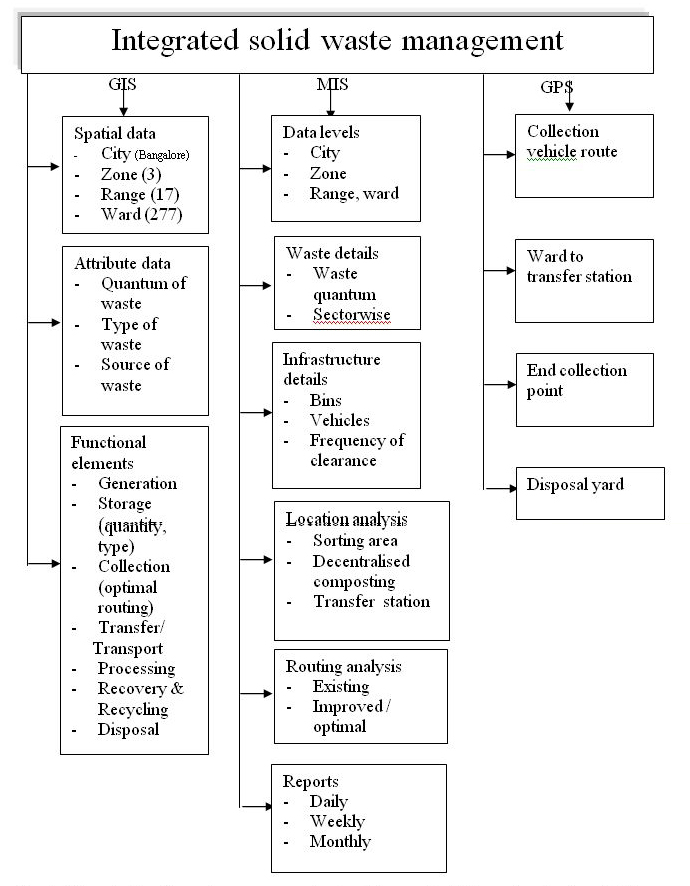
Fig. 2. Integrated solid waste management using Geographic Information System (GIS), Management Information System (MIS) and Global Positioning System (GPS)
GIS system for waste management in IISc campus
IISc is located in the northern part of Bangalore City having lush vegetation and campus has green canopy of trees covering the buildings. The campus limits are enclosed within 13.010550 to 13.020830 latitude and 77.559440 to 77.573880 longitude. The main campus covers around 180 hectares. IISc has 46 academic departments, two banks, one school, four canteens, one restaurant, four guest houses, 500 faculty members, 750 supporting staff, 1500 students and 750 residential quarters representing a typical urban community. The institute generates all kinds of waste arising from residential, commercial, education, open area and vegetative area.
Waste bins of different types are distributed around the campus. Collection of waste is done by one truck, one tractor and mini pick up trucks. The frequency of collection is 1 to 3 days. Collected waste is dumped or burnt at common dumping site about 12 kms away from IISc. Regular street sweeping and roadside garden trimmings are done and the waste is dumped in bins. Transferring of waste to vehicles is done manually. The current route of collection of waste is according to the convenience of the driver rather than from the collection point of view or from the type and composition of wastes. All sensitive bins are not given priority in this method of collection. It is desirable to evolve an optimal route on the basis of waste composition and quantities generated in each bin.
Integrating spatial information along with the corresponding attribute information was part of the study. Mapinfo 5.5 was used to create vector layers from the Survey of India (SOI) topographical maps of scale 1:1000. Digitised vector layers include: boundary, road network, building distribution, distribution of bins, open dumping sites, land use and land cover, optimal routing etc. Fig. 3 represents the land use of IISc campus. Fig. 4 depicts the proportion of waste generated in each zone. Fig. 5 shows locations where wastes are collected. Studies were carried out at active bin sites. Fig. 6 illustrates the optimal route for collection vehicle based on the different factors. Preference is given to collection of organic matter in order to avoid unaesthetic appearance, foul smell and animal problems. Optimal routing is arrived at in such a way that the zones with more domestic wastes are handled on priority while covering all zones and avoiding overlap. The corresponding micro routing for locations is based on the experience of collection workers. A particular locality is chosen and the two nodes (source and destination) information is provided as input for which the shortest route is to be computed through Dijkstra’s algorithm. Here all the arc and node information is stored in a table called arc and node. From the arc table, number of nodes and their length is found and stored in a matrix A (m x n). The entries in the matrix are
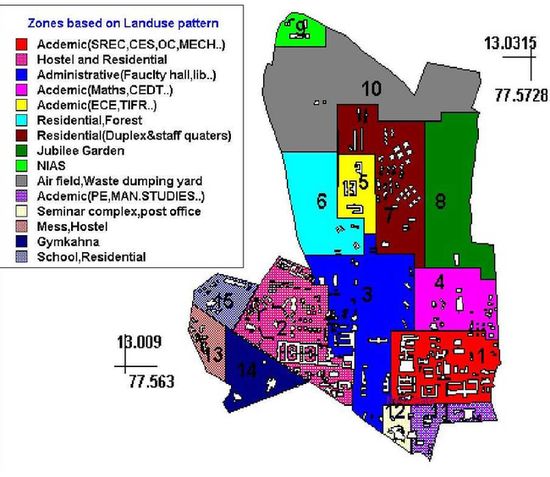
Figure 3. Zones of IISc campus based on land use spatial spread of buildings
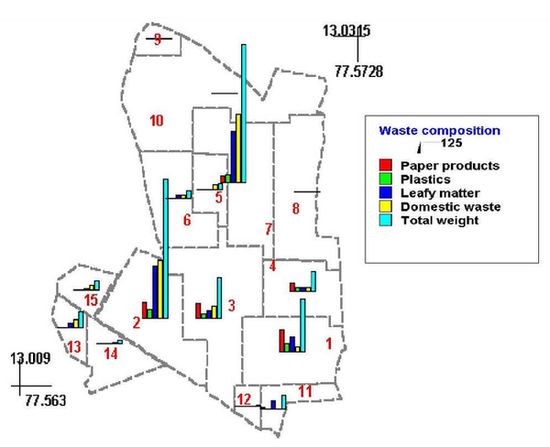
Figure 4. Proportion of waste generated
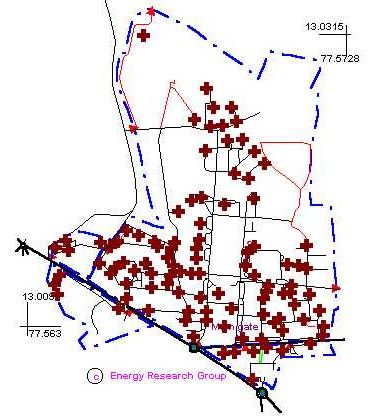
Figure 5. Waste collection points
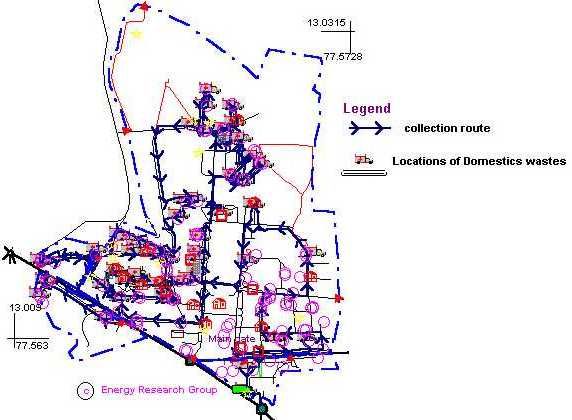
Figure 6. Optimal route for collection vehicle

Where, m : number of rows, n : number of columns, i : i th row and j : j th column.
Legal mandates
There are no environmental laws in the Karnataka Municipal Corporation Acts specifically pertaining to SWM. Solid waste management practices can never reach the desired level of efficiency until the public participates and discharges its obligation religiously. In order to improve solid management practices in urban areas it is necessary to incorporate suitable provisions in the state law to ensure public participation and providing for minimum level of solid waste management. Some of the proposed legal provisions are as follows:
Proposed scheme for ISWM
Some of the proposed schemes for any city or town are as follows;
Conclusion
Rapid population growth coupled with the increased rate of unplanned urbanization in many cities of the developing world, led to the tremendous increase in the amounts of municipal solid waste (MSW). Mismanagement of solid waste leads to public health risks, adverse environmental impacts and other socio-economic problems. The problems derived from solid waste have a unique and complicated character; they are not only a potential source of pollution, but they can be used as a secondary source of raw materials. Municipal solid waste management (MSWM) is considered a serious environmental challenge confronting local authorities, especially in developing countries. Currently, several countries have realized that the way they manage their solid wastes does not satisfy the objectives of sustainable development. Therefore, there is a move to shift from traditional solid waste management (SWM) options to more integrated solid waste management approaches. The selection of priorities regarding the solid waste management has direct economic and environmental impacts. This procedure concerns not only the environmental policy but also technological, economic and purchasing policies. However, the lack of adequate resources to implement the necessary changes is posing a serious obstacle. The application of planning tools such as Geographic Information System and Geospatial modelling for integrated management of municipal solid waste aided to conserve both natural and man-made resources while achieving economic viability through sustainable options in management and averting ecological risks.
Developments in the waste management systems in Bangalore is slow paced nevertheless a sincere one; however it needs upgradation in the areas of processing and disposal. Political and financial hurdles and lack of cooperation by the public in general has created bottlenecks in improving it’s efficiency. The potential of community participation, human resource development and legal mandates has to be realised and subsequent changes brought about. Adoptions of latest spatial analytical technologies such as MIS-GPS-GIS system have to be taken into consideration while developing a waste management system for Bangalore. The study on IISc campus can be used as a model for the wards in Bangalore. However for any waste management to be successful, the government should step up and take the required initiatives. Even though financial constraints are a part of the system, the government can make a formal and sincere commitment for an integrated SWM approach, fully recognising the advantages of the existing informal recycling network. Waste recycling can be promoted through consumer campaigns that will encourage citizens to co-operate in waste separation and to purchase recycled products. Also, waste authorities should encourage composting and biogasification of wastes, which will reduce the volume of waste to be disposed of. Finally, no SWM can be effective without proper monitoring of its disposal activities. Therefore its effectiveness should be tested on a regular basis.
References
| * Corresponding Author : | |||
| Dr. T.V. Ramachandra Energy & Wetlands Research Group, Centre for Ecological Sciences, Indian Institute of Science, Bangalore – 560 012, INDIA. Tel : 91-80-23600985 / 22932506 / 22933099, Fax : 91-80-23601428 / 23600085 / 23600683 [CES-TVR] E-mail : cestvr@ces.iisc.ac.in, energy@ces.iisc.ac.in, Web : http://wgbis.ces.iisc.ac.in/energy |
|||
| * Corresponding Author : | |||
| Dr. T.V. Ramachandra Energy & Wetlands Research Group, Centre for Ecological Sciences, Indian Institute of Science, Bangalore – 560 012, INDIA. Tel : 91-80-23600985 / 22932506 / 22933099, Fax : 91-80-23601428 / 23600085 / 23600683 [CES-TVR] E-mail : cestvr@ces.iisc.ac.in, energy@ces.iisc.ac.in, Web : http://wgbis.ces.iisc.ac.in/energy |
|||